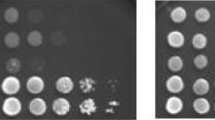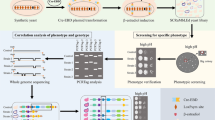Abstract
Saccharomyces cerevisiae strains with favorable characteristics are preferred for application in industries. However, the current ability to reprogram a yeast cell on the genome scale is limited due to the complexity of yeast ploids. In this study, a method named genome replication engineering-assisted continuous evolution (GREACE) was proved efficient in engineering S. cerevisiae with different ploids. Through iterative cycles of culture coupled with selection, GREACE could continuously improve the target traits of yeast by accumulating beneficial genetic modification in genome. The application of GREACE greatly improved the tolerance of yeast against acetic acid compared with their parent strain. This method could also be employed to improve yeast aroma profile and the phenotype could be stably inherited to the offspring. Therefore, GREACE method was efficient in S. cerevisiae engineering and it could be further used to evolve yeast with other specific characteristics.







Similar content being viewed by others
References
Abyzov A, Urban AE, Snyder M, Gerstein M (2011) CNVnator: an approach to discover, genotype and characterize typical and atypical CNVs from family and population genome sequencing. Genome Res 21(6):974
Akada R (2002) Genetically modified industrial yeast ready for application. J Biosci Bioeng 94(6):536–544
Becker DM, Guarente L (1991) [12] High-efficiency transformation of yeast by electroporation. Methods Enzymol 194:182
Brown WC, Duncan JA, Campbell JL (1993) Purification and characterization of the Saccharomyces cerevisiae DNA polymerase delta overproduced in Escherichia coli. J Biol Chem 268(2):982–990
Burgers PMJ, Gerik KJ (1998) Structure and processivity of two forms of Saccharomyces cerevisiae DNA polymerase δ. J Biol Chem 273(31):19756–19762
Cakar ZP, Turanliyildiz B, Alkim C, Yilmaz U (2012) Evolutionary engineering of Saccharomyces cerevisiae for improved industrially important properties. FEMS Yeast Res 12(2):171–182
Carey LB (2015) RNA polymerase errors cause splicing defects and can be regulated by differential expression of RNA polymerase subunits. Elife 4:e09945. https://doi.org/10.7554/eLife.09945
Drake JW (1991) A constant rate of spontaneous mutation in DNA-based microbes. Proc Natl Acad Sci USA 88(16):7160–7164
Galli A, Chan CY, Parfenova L, Cervelli T, Schiestl RH (2015) Requirement of POL3 and POL4 on non-homologous and microhomology-mediated end joining in rad50/xrs2 mutants of Saccharomyces cerevisiae. Mutagenesis 30(6):841–849
Han DW (2003) Functional genetics of industrial yeasts; of ancient skills and modern applications. Top Curr Genet 2:1–16
Herr AJ, Kennedy SR, Knowels GM, Schultz EM, Preston BD (2014) DNA replication error-induced extinction of diploid yeast. Genetics 196(3):677–691
Hill JE, Myers AM, Koerner TJ, Tzagoloff A (1986) Yeast/E. coli shuttle vectors with multiple unique restriction sites. Yeast 2(3):163–167
Ho SN, Hunt HD, Horton RM, Pullen JK, Pease LR (1989) Site-directed mutagenesis by overlap extension using the polymerase chain reaction. Gene 77(1):51–59
Hou L (2009) Novel methods of genome shuffling in Saccharomyces cerevisiae. Biotechnol Lett 31(5):671–677
Husnik JI, Volschenk H, Bauer J, Colavizza D, Luo Z, van Vuuren HJ (2006) Metabolic engineering of malolactic wine yeast. Metab Eng 8(4):315–323
Johnson RE, Klassen R, Prakash L, Prakash S (2015) A major role of DNA polymerase delta in replication of both the leading and lagging DNA strands. Mol Cell 59(2):163–175
Kozak BU, van Rossum HM, Niemeijer MS, van Dijk M, Benjamin K, Wu L et al (2016) Replacement of the initial steps of ethanol metabolism in Saccharomyces cerevisiae by ATP-independent acetylating acetaldehyde dehydrogenase. FEMS Yeast Res 16(2):fow006
Li H, Durbin R (2009) Fast and accurate short read alignment with Burrows–Wheeler transform. Bioinformatics 25(14):1754–1760
Li H, Durbin R (2010) Fast and accurate long-read alignment with Burrows–Wheeler transform. Bioinformatics 26(5):589–595
Li H, Handsaker B, Wysoker A, Fennell T, Ruan J, Homer N et al (2009) The sequence alignment/map format and SAMtools. Bioinformatics 25(16):2078–2079
Luan G, Bao G, Lin Z, Li Y, Chen Z, Li Y et al (2015) Comparative genome analysis of a thermotolerant Escherichia coli obtained by Genome Replication Engineering Assisted Continuous Evolution (GREACE) and its parent strain provides new understanding of microbial heat tolerance. New Biotechnol 32(6):732–738
Luan G, Cai Z, Li Y, Ma Y (2013) Genome replication engineering assisted continuous evolution (GREACE) to improve microbial tolerance for biofuels production. Biotechnol Biofuels 6(1):137
Lynch M (2010) Evolution of the mutation rate. Trends Genet 26(8):345–352
Morrison A, Johnson AL, Johnston LH, Sugino A (1993) Pathway correcting DNA replication errors in Saccharomyces cerevisiae. EMBO J 12(4):1467–1473
Morrison A, Sugino A (1992) Roles of POL3, POL2 and PMS1 genes in maintaining accurate DNA replication. Chromosoma 102(1):S147–S149
Netz DJ, Stith CM, Stumpfig M, Kopf G, Vogel D, Genau HM et al (2011) Eukaryotic DNA polymerases require an iron–sulfur cluster for the formation of active complexes. Nat Chem Biol 8(1):125–132
Pires EJ, Teixeira JA, Branyik T, Vicente AA (2014) Yeast: the soul of beer’s aroma—a review of flavour-active esters and higher alcohols produced by the brewing yeast. Appl Microbiol Biotechnol 98(5):1937–1949
Replogle K, Hovland L, Rivier DH (1999) Designer deletion and prototrophic strains derived from Saccharomyces cerevisiae strain W303-1a. Yeast 15(11):1141–1149
Roohvand F, Shokri M, Abdollahpour-Alitappeh M, Ehsani P (2017) Biomedical applications of yeast—a patent view, part one: yeasts as workhorses for the production of therapeutics and vaccines. Expert Opin Ther Pat 27(8):929–951. https://doi.org/10.1080/13543776.2017.1339789
Rosche WA, Foster PL (2000) Determining mutation rates in bacterial populations. Methods 20(1):4–17. https://doi.org/10.1006/meth.1999.0901
Selmecki AM, Maruvka YE, Richmond PA, Guillet M, Shoresh N, Sorenson AL et al (2015) Polyploid can drive rapid adaptation in yeast. Nature 519(7543):349–352
Shen N, Wang JJ, Liu CF, Li Y-X, Li Q (2013) Screening of brewer’s yeast with low acetaldehyde by directional domestication. Food Ferment Ind (in Chinese)
Shi DJ, Wang CL, Wang KM (2009) Genome shuffling to improve thermotolerance, ethanol tolerance and ethanol productivity of Saccharomyces cerevisiae. J Ind Microbiol Biotechnol 36(1):139–147
Shiwa Y, Fukushimatanaka S, Kasahara K, Horiuchi T, Yoshikawa H (2012) Whole-genome profiling of a novel mutagenesis technique using proofreading-deficient DNA polymerase δ. Int J Evol Biol 2012:860797. https://doi.org/10.1155/2012/860797
Si T, HamediRad M, Zhao H (2015) Regulatory RNA-assisted genome engineering in microorganisms. Curr Opin Biotechnol 36:85–90
Si T, Luo Y, Bao Z, Zhao H (2015) RNAi-assisted genome evolution in Saccharomyces cerevisiae for complex phenotype engineering. ACS Synth Biol 4(3):283–291
Si T, Xiao H, Zhao H (2015) Rapid prototyping of microbial cell factories via genome-scale engineering. Biotechnol Adv 33(7):1420–1432
Skretas G, Kolisis FN (2012) Combinatorial approaches for inverse metabolic engineering applications. Comput Struct Biotechnol J 3:e201210021
Smith JD, Suresh S, Schlecht U, Wu M, Wagih O, Peltz G et al (2016) Quantitative CRISPR interference screens in yeast identify chemical–genetic interactions and new rules for guide RNA design. Genome Biol 17:45
Steensels J, Snoek T, Meersman E, Nicolino MP, Voordeckers K, Verstrepen KJ (2014) Improving industrial yeast strains: exploiting natural and artificial diversity. FEMS Microbiol Rev 38(5):947–995
Tokuriki N, Tawfik D (2009) Stability effects of mutations and protein evolvability. Curr Opin Struct Biol 19(5):596–604
Venkatesan RN, Hsu JJ, Lawrence NA, Preston BD, Loeb LA (2006) Mutator phenotypes caused by substitution at a conserved motif A residue in eukaryotic DNA polymerase delta. J Biol Chem 281(7):4486–4494
Wang J, Shen N, Yin H, Liu C, Li Y, Li Q (2013) Development of industrial brewing yeast with low acetaldehyde production and improved flavor stability. Appl Biochem Biotechnol 169(3):1016–1025
Wang K, Li M, Hakonarson H (2010) ANNOVAR: functional annotation of genetic variants from high-throughput sequencing data. Nucleic Acids Res 38(16):e164
Wang ZY, Wang JJ, Liu XF, He XP, Zhang BR (2009) Recombinant industrial brewing yeast strains with ADH2 interruption using self-cloning GSH1 + CUP1 cassette. FEMS Yeast Res 9(4):574–581
Xu W, Wang J, Li Q (2014) Microarray studies on lager brewer’s yeasts reveal cell status in the process of autolysis. FEMS Yeast Res 14(5):714–728
Funding
This study was financially supported by the National Science Foundation (nos. 31571942, and 31601558), the National High Technology Research and Development Program 863 (no. 2013AA102106-03), Priority Academic Program Development of Jiangsu Higher Education Institutions (PAPD), Program of Introducing Talents of Discipline to Universities (no. 111-2-06), and the Fundamental Research Funds for the Central Universities (JUSRP51306A, JUSRP51402A and JUDCF13008).
Author information
Authors and Affiliations
Corresponding author
Ethics declarations
Conflict of interest
All authors declare that they have no conflict of interest.
Ethical approval
This article does not contain any studies with human participants or animals performed by any of the authors.
Electronic supplementary material
Below is the link to the electronic supplementary material.
Rights and permissions
About this article
Cite this article
Xu, X., Liu, C., Niu, C. et al. Rationally designed perturbation factor drives evolution in Saccharomyces cerevisiae for industrial application. J Ind Microbiol Biotechnol 45, 869–880 (2018). https://doi.org/10.1007/s10295-018-2057-x
Received:
Accepted:
Published:
Issue Date:
DOI: https://doi.org/10.1007/s10295-018-2057-x




